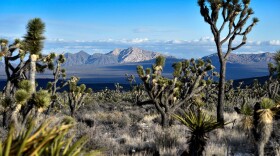What’s the best Southern Nevada trail to hike in winter?” seems an innocuous question, but it ended in a newsroom fight: Arizona Hot Spring versus Gass Peak. You can see by the headline which side I was on, and here’s why: The last time I hiked Arizona Hot Spring, I saw tourists carrying their yard-longs and wearing flip-flops. That place has been discovered. For something with a higher barrier of entry, head to the Desert National Wildlife Refuge (DNWR) and get the best city view of any nearby mountain peak.
Trail name: Gass Peak
The DNWR, about 30 miles from Las Vegas off U.S. 95, is not hidden, but still a gem that many miss out on due to the trails’ inaccessibility. (If you don’t have a high-clearance vehicle, you should still go, as the Corn Creek Visitor Center is very cool and has family-friendly walks.) Gass Peak is even more daunting because of its steep climbs and lack of shade, so this is not a summer hike. In cool weather, though? Perfect for adventurers.
How to get there: From Corn Creek, turn right onto Mormon Well Road, go a little more than four miles, and go right again on Gass Peak Road. The parking lot and trailhead are on the right, eight miles up.
Distance: 6.2 miles
Elevation gain: 2,037 feet
Ancestral territory of: Southern Paiutes
Civics lesson: The refuge is comanaged by the U.S. Fish and Wildlife Service (Department of Interior) and the U.S. Air Force (Department of Defense). Using the annually approved National Defense Authorization Act, the defense department has, a few times, sought to shift land out of public use and into its sole jurisdiction, so that the Air Force can use it for flight training maneuvers. The most recent attempt resulted in pending compromise legislation, proposed by two Nevada senators. If approved, it would provide wilderness protection for the public side of the refuge.
Tread lightly: The DNWR was established to protect desert bighorn sheep, but it’s home to hundreds of other species of plants and animals, including the Desert Tortoise (see p. 70), Joshua Tree, Golden Eagle, Greater Roadrunner, and Pahrump Poolfish (which you can see at Corn Creek). While on the trail, look for the Blue Diamond Cholla, Southern Nevada’s endemic, rare cactus.








